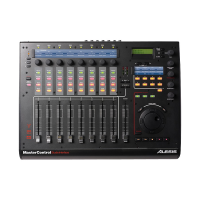22.32 hoover emulation:
Go for it here! Use the tips in this document to aid you (particularly the bass and lead tips)
http://kickme.to/hoovers
22.33 sysex and the a6:
Reid Woodbury wrote:
To start, a complete listing of the A6 sysex commands is available at my web site (Alesis gave
permission):
http://www.rawsound.com/programs/A6_SysEx.pdf
And yes you've seen this before. The A6 uses the same basic sysex commands and data formatting
as their QS series of synths.
The A6 is run by a normal type processor that uses 8-bit bytes. We're all used to that. Data in the A6
banks are either 1-bit flags (in groups of 8, 16 or 32), 8-bit numbers or characters, 2-byte (16-bit)
numbers, and in a few cases 4 byte numbers.
Serial communication (RS-232 & 422) can send bytes from 5 to 8 bits in size. Pretty much all serial
communication has defaulted to 8-bits for the last 15 years, including MIDI which is based on that
spec.
Why did I go through all of that? Just to show that "8-bits" is pretty much carved in stone... er silicon.
And using 7 or 14 bit numbers really isn't normal.
But, even though MIDI uses 8-bit bytes, the first bit in a MIDI byte is reserved for what I think of as
the "do it now" bit, ie. note on, note off, controller, etc. Any MIDI byte with a 1 in the highest position
is a command and most all those bytes are defined by the MIDI spec. That means for raw data the
top bit must zero leaving only 7 bits available. Normal 8-bit grouped data must be sent out only 7-
bits at a time taking 8 serial/MIDI bytes to transmit 7 whole bytes of real data. (Unless you want to
get into data compression algorithms. But not here.)
OK, you knew that. It's here for clarity.
Alesis refers to this as packing. I'm a little more fancy and call it "8/7 encoding" referring to the bits
per byte. If you have 7 normal bytes laid-out like this (B=byte, b=bit; be sure you're using a mono-
spaced font for viewing):
B | b8 b7 b6 b5 b4 b3 b2 b1 [ordinal numbering!]
-- ------------------------
1 | A8 A7 A6 A5 A4 A3 A2 A1 [byte A or 1st]
2 | B8 B7 B6 B5 B4 B3 B2 B1 [byte B or 2nd]
3 | C8 C7 C6 C5 C4 C3 C2 C1 [byte C or 3rd]
4 | D8 D7 D6 D5 D4 D3 D2 D1 [byte D or 4th]
5 | E8 E7 E6 E5 E4 E3 E2 E1 [byte E or 5th]
6 | F8 F7 F6 F5 F4 F3 F2 F1 [byte F or 6th]
7 | G8 G7 G6 G5 G4 G3 G2 G1 [byte G or 7th]
then you'd have 8 transmitted bytes mapped like this ("oo" means bit is set to zero):
B | b8 b7 b6 b5 b4 b3 b2 b1
-- ------------------------
1 | oo A7 A6 A5 A4 A3 A2 A1
2 | oo B6 B5 B4 B3 B2 B1 A8
3 | oo C5 C4 C3 C2 C1 B8 B7
4 | oo D4 D3 D2 D1 C8 C7 C6
5 | oo E3 E2 E1 D8 D7 D6 D5
6 | oo F2 F1 E8 E7 E6 E5 E4

